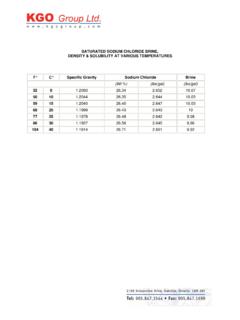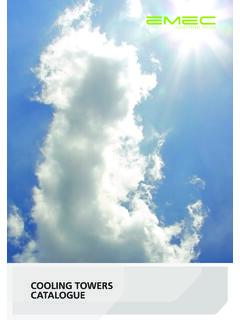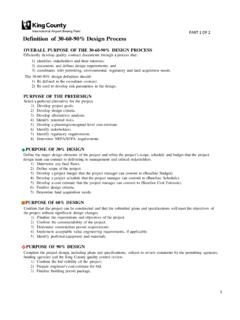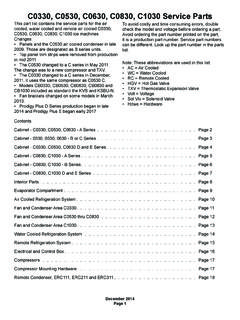Transcription of Cooling Tower Basics and Common Misconceptions2 - KGO …
1 Jalal Engineering, Page 1 of 6 Cooling Tower Basics and Common Misconceptions Introduction In comparison with most other industrial equipments, the water Cooling Tower is a simple device, based on the direct contact of two of the earth s most Common substances: air and water; yet a surprising number of misconceptions on its design, operation and behavior prevail. Cooling Basics and important misconceptions are discussed herein, with the goal of helping to achieve the most economical and beneficial application, design, and operation of this important heat transfer device. Cooling Tower Fundamentals Heat Transfer: The basic principle of the Cooling Tower operation is that of evaporative condensation and exchange of sensible heat. The air and water mixture releases latent heat of vaporization which has a Cooling effect on water by turning a certain amount of liquid into its gaseous state thereby releasing the latent heat of vaporization.
2 This is more effectively demonstrated by wetting the back of your hand with water and blowing on it. This effect is what happens inside the Cooling Tower . The air stream releases latent heat of vaporization thereby dropping the temperature of the water on your skin. The liquid changing to its vaporous state consumes heat which is taken from the water remaining, thus lowering its temperature. There is a penalty involved, and that is loss of water which goes up to the Cooling Tower and is discharged into the atmosphere as hot moist vapor. Under normal operating conditions, this amounts to approximately for each 10 oF Cooling range. Sensible heat that changes temperature is also responsible for part of the Cooling Tower s operation. When water is warmer that the air, there is a tendency for the air to cool the water.
3 The air then gets hotter as it gains the sensible heat of the water and the water is cooled as its sensible heat is transferred to the air. Approximately 25% of the sensible heat transfer occurs in the Tower while the balance of the 75% Cooling is due to the evaporative effect of latent heat of vaporization. Dry Bulb Temperature [DBT], Wet Bulb Temperature [WBT] and Relative Humidity [RH]: The temperature of air as read on the ordinary thermometer is called DBT. WBT is the reading when the bulb of a thermometer is covered with a wet cloth, and the instrument is whirled around in a sling. RH is the ratio of the quantity of water vapor present in a cubic feet of air to the greatest amount of vapor which that air could hold at a given temperature. When the relative humidity is 100%, the air cannot hold any more water and therefore, water will not evaporate in 100% humid air.
4 When the RH is 100% the WBT is the same as the DBT, because the water cannot evaporate any more. But when the RH is less than 100%, the WBT will be less than the DBT and water will evaporate. The capability of the Cooling Tower is a measure of how close the Tower can bring the water temperature to the WBT of the entering air. A larger Cooling Tower [ , more air and/or more fill] will produce a closer approach [colder leaving water] for a given heat load, flow rate and entering air condition. The lower the WBT, which indicates either cool air, low humidity or a combination of the two, the lower can the Cooling Tower can cool the water. The thermal performance of the Cooling Tower is thus affected by the entering WBT; the entering air DBT has an insignificant effect on thermal performance.
5 In actual practice, the final cold water temperature will always be at least a few degrees above WBT, depending on design conditions. It is not customary in the Cooling Tower industry to guarantee any approach less than 5 oF. Jalal Engineering, Page 2 of 6 SATURATED AIR FILM,Enthalpy: hWAIR, Enthalpy: hA AIR, Enthalpy: hA WATERDROPLETFIG. 55 60 65 70 75 80 85 90 95 100 105 110 115 120 TEMPERATURE [F]1/ [ Hw - Ha1 / [ hW hA ] Performance Demand [KaV/L] is area under 3010203040506070809010011012013014050 55 60 65 70 75 80 85 90 95 100 105 110 115 120 TEMPERATURE [F]ENTHALPY [Btu/ WBT Water Operating Line, hwAir Operating Line, hAEnthalpy Driving Force: hw-hASaturation Curve ENTHALPY [Btu/lb] Tan = L/G CWT HWT FIG.]]
6 2 Cooling Tower [Counter Flow] Theory Merkel Equation Figure 1 illustrates a drop of water falling through an upstream of unsaturated air at a wet bulb temperature of WBT with enthalpy hA , in a counter flow Cooling Tower . The drop of water is assumed to be surrounded by a film of saturated air at the water temperature WT with saturation enthalpy hW. As the drop travels downward, heat and mass transfer takes place from the interface air film to the up stream air, thereby Cooling the water from HWT to CWT. This Cooling process can best be explained on a Psychometric Chart. The process is shown in figure 2 known as the Driving Force Diagram. The air film is repre sented by the Water Operating Line on the Saturation Curve. The main air is represented by the Air Operating Line, the slope of which is the Water/Air [L/G] ratio.
7 The Cooling charac teristic, a degree of difficulty to Cooling is represented by the Merkel Equation: The Merkel Equation primarily says that at any point in the Tower , heat and water vapor are transferred into the air due [approximately] to the differen ce in the enthalpy of the air at the surface of the water and the main stream of the air. Thus, the driving force at any point is the vertical distance between the two operating lines. And therefore, the performance demanded from the Cooling Tower is the inverse of this difference. The solution of the Merkel Equation can be represented by the Performance Demand Diagram shown in figure 3. The KaV/L value is equal to the area under the curve. An increase in the entering WBT moves the Air Operating Line towards the right and upward to establish equilibrium.
8 Both the CWT and HWT increases, while the approach decreases. The curvature of the saturation line is such that the approach decreases at a progressively slower rate as the WBT increases. An increase in the heat load increases the Cooling ranges and increases the length of the Air Operating Line. To maintain equilibrium, the line shifts to the right increasing the HWT, CWT, and =HWTCWTAW hhdtL/KaVJalal Engineering, Page 3 of 6 approach. The increase causes the hot water temperature to increase considerably faster than does the cold water temperature. In both these cases, the KaV/L should remain constant. However, a change in L/G will change the KaV/L value. Cooling Tower Designing On the basis of the above discussion, it is clear that there are five parameters that in combination dictate and define the performance of a Cooling Tower : 1.
9 Hot Water Temperature HWT, 2. Cold Water Temperature CWT, 3. Wet Bulb Temperature WBT, 4. Water Flow Rate L, 5. Air Flow Rate G. The first four data are the ones, which are given by the user. The fifth one [G], is selected by the Cooling Tower designer. Once these five data are available, the Tower characteristic [KaV/L], can be calculated through the Merkel Equation. The first step in Cooling Tower designing is the generation of a Demand Curve. In this curve, the KaV/L values are plotted against varying the L/G ratios. The next step is to superimpose fill characteristics curves and demand curves.[ Cooling Technology Institute has tested a variety of fill configurations and generated fill characteristic curves for each type; CTI s Technical Paper TP88 05 can be referred to in this regard.]
10 ] Cooling Tower designing is basically an iterative process. The factors that effect the selection of design L/G and consequently the fill height are: cell dimensions, water loading, air velocities across various Cooling Tower sections and pressure drops, and fan selection. Please refer to figure 5 below, which is a screen print of Jalal Engineering s Cooling Tower designing program. Fill ft. uve r Velo city-FPMW a te r Lo a d ing -GP M/ s ft:G -lb/min: [per Cell] Leng th-ftEnthalp y- e t-Bulb T e mp .-oFCT Designing Standard: CT Ve l. Press. -in. [w/ o vel. recovery]Air Velocity Across Fill - Height Required - tor Sha ft Power -HP:Gear Eff. -%Number of Cells:L/G:Fill Safety Factor CFM / Ce ll: louver Heig ht -ftFill Height to be Installed -ft:Free area -% ll Mo d e l:L -lb /min: [pe r Cell]11, Load -Ton[R]Fill DesignationCOOLING Tower DESIGNINGHWT-oFCWT-oF181,97812Ka V / L p e r ft.









